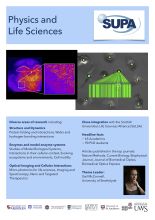
Physics often plays a fundamental role in developments within the life sciences. To the lay person Physics is perhaps perceived to have its greatest responsibility in the development of advanced technology for medicine. However, our vision for PaLS goes significantly beyond this generalisation. We wish physics to challenge the way that life scientists perceive and understand the biological world and for life scientists to challenge physicists to develop new and exciting technology and techniques to enable novel research. Thus the relationship is synergistic to the benefit of both sciences.
Scottish physicists already pursue internationally visible research in many areas at the physics/life sciences interface: life science-related grants held by physicists spread over all five SUPA themes in the 2001-2008 RAE period totalled £30+M. Our vision is to integrate, strengthen and exploit Scottish PaLS research and graduate training, and take Scotland to a world-leading level in this area. In collaboration with the Scottish Universities Life Sciences Alliance (SULSA) we are building strategic linkages with Scottish life sciences and biomedical research.
The research within PALS can be classified into three broad themes:
Structure and Dynamics
- Protein folding and interactions
- Water and hydrogen-bonding interactions
Enzymes and model enzyme systems
- Studies of Model Biological Systems
- Interactions in their cellular context
- Evolving ecosystems and environments
- Cell motility
Optical Imaging and Cellular Interactions
- Micro-photonics for life sciences
- Imaging and Spectroscopy
- Nano and Targeted Therapeutics
Download the Physics and Life Sciences leaflet:
Theme Leader: Stuart Reid (stuart.reid@strath.ac.uk)
Illustrations in banner (from left):
2D-IR spectroscopy for the determination of the 3D structure and femtosecond dynamics of proteins
The 6-helix core of the protein gp41 from the Human Immunodeficiency Virus
Amyloid-like fibrils assembled from insulin, imaged by Atomic Force Microscopy
The transparent egg-white gel of an artificial Chinese “Century” egg
A single E.coli bacterium with multiple helical flagella
© The University of Edinburgh
